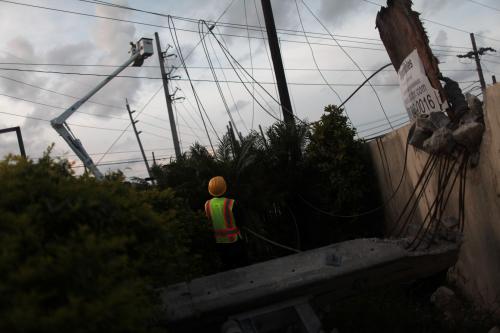The Bureau of Labor Statistics (BLS) employment report released today shows that 228,000 jobs were added in November. In this blog post, I report results from three alternative projections, each of which was calculated using methodology outlined in my past research. Applying a more stable seasonal adjustment to the raw data, and accounting for the effects of weather on employment yields 260,000 jobs, 32,000 above the BLS Official number. The higher estimate attempts to measure the economy’s underlying hiring trend and assumes that the residual effects of hurricanes Harvey and Irma are not significant—as the economies of Florida and Texas seem to be close to normal operation. However, there may still be some construction employment in the Florida and Texas that cannot be accounted for in our estimate until state-level employment data are released later this month.
Calculating the Alternative Seasonal Adjustment
Monthly job gains and losses can indicate how the economy is doing once they are corrected to account for the pattern the BLS already expects in a process called seasonal adjustment. The approach for this seasonal adjustment that is presently used by the BLS puts very heavy weight on the current and last two years of data in assessing what are the typical patterns for each month.
In my 2013 paper “Unseasonal Seasonals?” I argue that a longer window should be used to estimate seasonal effects. I find that using a different seasonal filter, known as the 3×9 filter, produces better results and more accurate forecasts by emphasizing more years of data. The 3×9 filter spreads weight over the most recent six years in estimating seasonal patterns, which makes them more stable over time than the current BLS seasonal adjustment method.
To produce the Alternative Seasonal Adjustment, I calculate the month-over-month change in total nonfarm payrolls, seasonally adjusted by the 3×9 filter, for the most recent month, which you can see in table below. The corresponding data as published by the BLS are shown for comparison purposes. According to the Alternative Seasonal Adjustment, the economy added 241,000 jobs in November, 13,000 more than the official BLS total of 228,000.
Calculating the Seasonal and Weather Adjustment
In addition to seasonal effects, abnormal weather can also affect month-to-month fluctuations in job growth. In my 2015 paper with Michael Boldin “Weather-Adjusting Economic Data,” we implement a statistical methodology for adjusting employment data for the effects of deviations in weather from seasonal norms. This is distinct from seasonal adjustment, which only controls for the normal variation in weather across the year. We use several indicators of weather, including temperature and snowfall.
Temperatures in November were about 1 °C cooler than average, while temperatures in October were nearly 2½ °C warmer. I estimate that the warm temperatures in October inflated October’s jobs numbers by 12,000 jobs, while the cooler November temperatures deflated November’s jobs numbers by 10,000 jobs. The Seasonal and Weather Adjusted estimate for November is thus higher than the BLS estimate, showing that 238,000 jobs were added in the past month.
Combining the Alternative Seasonal and Weather Adjustments
Both my Alternative Seasonal Adjustment and Seasonal and Weather Adjustment show higher job gains than reported by the BLS. One can indeed do the two adjustments jointly—both adjusting for weather effects and using a longer window. This is shown in the far-right column of the table labeled Combined Alternative Seasonal and Weather Adjustment.
The results of the joint adjustments produce an increase of 260,000 jobs in November, which is modestly higher than the BLS Official number, and also higher than any other job addition estimate this year.
Today’s estimates for the effects of weather do not take into account hurricanes Harvey and Irma, which clearly had large effects on the previous two jobs reports. The rebuilding effort, coupled with establishments resuming normal operations, likely somewhat boosted jobs growth in November. However, looking at state-level employment numbers for September and October, employment in Texas and Florida more than recouped their September losses in October. Perhaps this is in part because Hurricane Irma ended up tracking farther west than expected. Many establishments may have closed, but not been greatly damaged, and thus resumed normal operations fairly quickly.
Therefore, I believe the impact of the hurricanes on the November data was negligible.
| Thousands of jobs added | BLS Official | Alternative Seasonal Adjustment[1] | Seasonal and Weather Adjustment[2] | Weather Effect[3] | Combined Alternative Seasonal and Weather Adjustment[4] |
|---|---|---|---|---|---|
| 2017-November | 228 | 241 | 238 | -10 | 260 |
| 2017-October | 244 | 249 | 232 | +12 | 246 |
| 2017-September | 38 | 17 | 44 | -6 | 3 |
| 2017-August | 208 | 208 | 217 | -9 | 217 |
| 2017-July | 138 | 158 | 122 | +16 | 137 |
| 2016-June | 210 | 218 | 209 | +1 | 225 |
| 2016-May | 145 | 131 | 165 | -20 | 144 |
| 2016-April | 207 | 201 | 172 | +35 | 179 |
| 2016-March | 50 | 26 | 105 | -55 | 85 |
| 2016-February | 232 | 254 | 208 | +24 | 217 |
| 2016-January | 216 | 201 | 193 | +23 | 187 |
| 2016-December | 155 | 163 | 164 | -9 | 171 |
| 2016-November | 164 | 185 | 153 | +11 | 168 |
Note: Changes in previous months’ numbers reflect revisions to the underlying data.
[1] Applies a longer window estimate of seasonal effects (see Wright 2013).
[2] Includes seasonal and weather adjustments, where seasonal adjustments are estimated using the BLS window specifications (see Boldin & Wright 2015).
[3] BLS Official number less the Seasonal and Weather Adjustment number.
[4] Includes seasonal and weather adjustments, where seasonal adjustments are estimated using a longer window estimate.






Commentary
After weathering the storms, jobs numbers are back on track
December 8, 2017